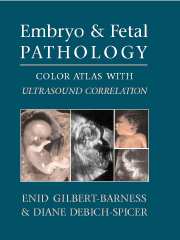Book contents
- Frontmatter
- Contents
- Foreword by John M. Opitz
- Preface
- Acknowledgments
- 1 The Human Embryo and Embryonic Growth Disorganization
- 2 Late Fetal Death, Stillbirth, and Neonatal Death
- 3 Fetal Autopsy
- 4 Ultrasound of Embryo and Fetus: General Principles
- 5 Abnormalities of Placenta
- 6 Chromosomal Abnormalities in the Embryo and Fetus
- 7 Terminology of Errors of Morphogenesis
- 8 Malformation Syndromes
- 9 Dysplasias
- 10 Disruptions and Amnion Rupture Sequence
- 11 Intrauterine Growth Retardation
- 12 Fetal Hydrops and Cystic Hygroma
- 13 Central Nervous System Defects
- 14 Craniofacial Defects
- 15 Skeletal Abnormalities
- 16 Cardiovascular System Defects
- 17 Respiratory System
- 18 Gastrointestinal Tract and Liver
- 19 Genito-Urinary System
- 20 Congenital Tumors
- 21 Fetal and Neonatal Skin Disorders
- 22 Intrauterine Infection
- 23 Multiple Gestations and Conjoined Twins
- 24 Metabolic Diseases
- Appendices
- Index
Preface
Published online by Cambridge University Press: 23 February 2010
- Frontmatter
- Contents
- Foreword by John M. Opitz
- Preface
- Acknowledgments
- 1 The Human Embryo and Embryonic Growth Disorganization
- 2 Late Fetal Death, Stillbirth, and Neonatal Death
- 3 Fetal Autopsy
- 4 Ultrasound of Embryo and Fetus: General Principles
- 5 Abnormalities of Placenta
- 6 Chromosomal Abnormalities in the Embryo and Fetus
- 7 Terminology of Errors of Morphogenesis
- 8 Malformation Syndromes
- 9 Dysplasias
- 10 Disruptions and Amnion Rupture Sequence
- 11 Intrauterine Growth Retardation
- 12 Fetal Hydrops and Cystic Hygroma
- 13 Central Nervous System Defects
- 14 Craniofacial Defects
- 15 Skeletal Abnormalities
- 16 Cardiovascular System Defects
- 17 Respiratory System
- 18 Gastrointestinal Tract and Liver
- 19 Genito-Urinary System
- 20 Congenital Tumors
- 21 Fetal and Neonatal Skin Disorders
- 22 Intrauterine Infection
- 23 Multiple Gestations and Conjoined Twins
- 24 Metabolic Diseases
- Appendices
- Index
Summary
This Atlas represents almost 50 years of study of embryos, fetuses, and perinatally dead infants. It includes more than 200 ultrasound images essential to modern diagnosis and important in the correlation with pathologic examination and for genetic counseling. In the past, products of conception frequently have been discarded or given only a cursory pathologic examination; however, in recent years it has become important to carefully examine these specimens and study embryonic tissue to accurately determine the nature and cause of prenatal death.
The Atlas includes more than 2000 illustrations in color,with abrief text of essential concepts and comments. Generous use of tables is made to replace more extensive text and important references are given at the end of each chapter.
A catalog of genetic syndromes with updated references is available through OnLine Mendelian Inheritance in Man OMIM (http://www3.ncbi.nlm.nih.gov/ omim/). In general, OMIM does not provide specific testing sites but often discusses the potential for molecular testing and gives references that can be used to contact experts in the field.
It is our hope that this volume will be a useful reference for obstetricians engaged in fetalmaternal and reproductive medicine, geneticists, pediatricians – neonatologists, in particular, and pathologists who have an interest in pediatric and genetic pathology.
- Type
- Chapter
- Information
- Embryo and Fetal PathologyColor Atlas with Ultrasound Correlation, pp. xiii - xivPublisher: Cambridge University PressPrint publication year: 2004

